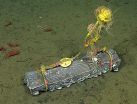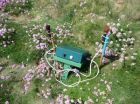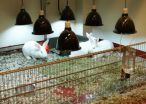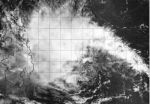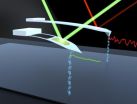(Press-News.org) MOSS LANDING, CA — When it comes to food, most of the deep sea is a desert. Many seafloor animals feed on marine snow—the organic remnants of algae and animals that live in the sunlit surface waters, far above. However, marine snow only falls as a light dusting and doesn't have much nutritional value. Thus, any other sources of food that reach the deep sea provide a temporary feast. Even bits of dead wood, waterlogged enough to sink, can support thriving communities of specialized animals. A new paper by biologists at the National Evolutionary Synthesis Center and the Monterey Bay Aquarium Research Institute (MBARI) shows that wood-boring clams serve as "ecosystem engineers," making the organic matter in the wood available to other animals that colonize wood falls in the deep waters of Monterey Canyon.
In 2006, marine biologists Craig McClain and Jim Barry used MBARI's remotely operated vehicle Tiburon to place 36 bundles of acacia wood on the canyon floor, 3,200 meters below the sea surface. Five years later, they retrieved the bundles and McClain painstakingly picked out every animal that had colonized the logs.
McClain performed a variety of statistical analyses on the different types of animals found in each of the bundles, looking for differences and similarities. The results were surprising. Even though all of the bundles contained exactly the same type of wood and were placed on the seafloor at the same time, within a few tens of meters of each other, there were huge differences in the numbers and types of animals from one bundle to another.
Some of the bundles had been heavily colonized. The seafloor around and under these bundles was carpeted with tiny wood chips and fecal pellets from wood-boring clams, as well as bacteria and fungi that help decompose this organic matter. Other wood bundles had few, if any animals living in them, and lacked these "halos" of discolored sediment.
McClain's statistical analysis showed that as the wood got older and more heavily colonized by wood-boring clams (Xylophaga zierenbergi), the types and abundances of other animals also changed. Boring clams are one of the few marine animals that can digest the cellulose in wood. Like termites, these clams have specialized symbiotic bacteria in their bodies that help them digest cellulose. As McClain put it, "Without these wood-boring bivalves, the carbon energy in the wood would not be available to other species."
McClain calls these clams "ecosystem engineers." He explains, "Like oysters, beavers, and termites, these boring clams alter the landscape and provide new habitat for other species."
As they eat their way through a sunken log, boring clams create lots of small holes in which other animals can hide. Their wood chips and feces provide food for a variety of smaller animals. And the clams themselves provide food for specialized predators.
The details of these interactions are still poorly known. For example, after boring clams, the most common animals McCain found in his bundles were tiny, shrimp-like crustaceans known as tanaids. The authors speculate that these tanaids may prey directly on the boring clams. Alternatively, the tanaids may consume the fecal pellets of boring clams and the bacteria associated with them (any organic matter is precious when you're three kilometers below the ocean surface).
The statistical analyses also showed that large logs supported more diverse communities of animals than small logs. The researchers speculated that larger logs may provide food for a longer time period, which attracts more secondary colonizers, such as deep-sea snails. McClain explained, "Snails, contrary to what you might expect, are metabolically expensive. They may need a lot of energy, such as that found a large wood fall, to support a viable population."
One of the most surprising discoveries was that, even after five years, some bundles contained only a few small, young boring clams, and other bundles contained no clams at all. The researchers could find no obvious reasons why the clams would colonize some bundles but not others.
McClain said, "The part that really excites and puzzles me is that not all the wood falls were colonized at the same time. At the end of the experiment some wood was not bored or bored very little. This didn't reflect the placement, size, cut, or surface area of the logs. Basically it appears that the recruitment of larval clams into the wood fall was a nearly random process, even for logs that were just a few meters from one another."
The rate at which a wood fall is colonized makes a big difference to deep-sea organisms living nearby. The faster that a piece of wood is colonized, the more rapidly its organic matter is made available to non-wood-eating animals. Thus, hard woods or woods containing clam-repellent compounds, might last much longer than soft woods, and might provide less food for animals on the nearby seafloor.
Whatever the reason, these differences in colonization from one wood fall to another created a wide variety of habitats and animal communities over a relatively small patch of seafloor. Thus, this study adds to the growing body of evidence that, although the deep seafloor may look flat and uniform, its animal communities often vary considerably over both space and time.
INFORMATION:
Online version of this release:
http://www.mbari.org/news/news_releases/2014/woodfalls/woodfalls-release.html
Images related to this release:
http://www.mbari.org/news/news_releases/2014/woodfalls/woodfalls-images.html
Original journal article:
McClain, C., and Barry, J. (2014) Beta-Diversity on deep-sea wood falls reflects gradients in energy availability. Biology Letters 10 (4): April, 2014; doi:10.1098/rsbl.2014.0129
Link to journal article on the web:
http://rsbl.royalsocietypublishing.org/content/10/4/20140129.full
Sunken logs create new worlds for seafloor animals
2014-04-09
ELSE PRESS RELEASES FROM THIS DATE:
Scientists reconstruct ancient impact that dwarfs dinosaur-extinction blast
2014-04-09
WASHINGTON, D.C. -- Picture this: A massive asteroid almost as wide as Rhode Island and about three to five times larger than the rock thought to have wiped out the dinosaurs slams into Earth. The collision punches a crater into the planet's crust that's nearly 500 kilometers (about 300 miles) across: greater than the distance from Washington, D.C. to New York City, and up to two and a half times larger in diameter than the hole formed by the dinosaur-killing asteroid. Seismic waves bigger than any recorded earthquakes shake the planet for about half an hour at any one ...
Counting the invisible by sound -- a new approach to estimate seabird populations
2014-04-09
AUDIO:
This is a typical one minute recording of an active Cory's Shearwater colony on the island of Corvo in the North Atlantic Ocean, June 2011.
Click here for more information.
Seabirds nest in places that are inaccessible for most humans - vertical cliffs and remote islands surrounded by raging waves. Worse still, many seabirds lay their eggs in burrows or cavities where they are protected from inclement weather and invisible for researchers. Hidden under rocks or in burrows ...
Rabbits kept indoors could be vitamin D deficient
2014-04-09
CHAMPAIGN, Ill. — Rabbits that remain indoors may suffer from a lack of vitamin D, researchers report in a new study. In rabbits kept as pets or used in laboratory studies, the deficiency could lead to dental problems, undermine their cardiovascular health, weaken their immune systems and skew scientific findings.
The study found that regular exposure to artificial ultraviolet B light for two weeks doubled rabbits' serum vitamin D levels – an increase not seen in animals raised in artificial light lacking UVB radiation. Future studies will seek to determine optimal levels ...
Recycling astronaut urine for energy and drinking water
2014-04-09
On the less glamorous side of space exploration, there's the more practical problem of waste — in particular, what to do with astronaut pee. But rather than ejecting it into space, scientists are developing a new technique that can turn this waste burden into a boon by converting it into fuel and much-needed drinking water. Their report, which could also inspire new ways to treat municipal wastewater, appears in the journal ACS Sustainable Chemistry & Engineering.
Eduardo Nicolau, Carlos R. Cabrera and colleagues point out that human waste on long-term journeys into ...
Can animals really help people in hospitals, aged care?
2014-04-09
While many people have an opinion on whether animals can help to improve wellbeing and care for patients in hospitals, does anyone really know whether there are benefits both for the patients and the animals themselves?
Not according to a team of researchers from the University of Adelaide, which has conducted a worldwide review of all studies looking at the impact of "animal interventions" in healthcare settings for children.
The researchers, from the University's School of Psychology and School of Animal and Veterinary Sciences, have found that despite theories emerging ...
NASA satellite sees Tropical Depression Peipah crawling toward Philippines
2014-04-09
NASA-NOAA's Suomi NPP satellite passed over the remnants of Tropical Depression Peipah on April 9 as the storm slowly approached the Philippines from the east. According to the Joint Typhoon Warning Center, Peipah is now not expected to make landfall in eastern Visayas until April 12.
The Visible Infrared Imaging Radiometer Suite or VIIRS instrument aboard Suomi NPP captured a visible, high-resolution image of the storm as it continued moving through the Philippine Sea. The storm appeared disorganized in the image, and the center was difficult to pinpoint on the visible ...
Promising agents burst through 'superbug' defenses to fight antibiotic resistance
2014-04-09
In the fight against "superbugs," scientists have discovered a class of agents that can make some of the most notorious strains vulnerable to the same antibiotics that they once handily shrugged off. The report on the promising agents called metallopolymers appears in the Journal of the American Chemical Society.
Chuanbing Tang and colleagues note that the antibiotic-resistant bacteria known as MRSA (methicillin-resistant Staphylococcus aureus) is responsible for a significant fraction of the infections that patients acquire in hospitals. According to the Centers for ...
Pharma firms turn attention to hearing loss
2014-04-09
Hearing loss affects 36 million Americans to some degree, often leaving them feeling isolated, but it has received little attention from the pharmaceutical industry — until now. Small firms have brought a handful of potential therapies to the development pipeline, and pharmaceutical heavyweights are taking notice, according to an article in Chemical & Engineering News (C&EN), the weekly magazine of the American Chemical Society.
The story states that the most common cause of hearing loss is loud noise, either from a single event like the bang of a firecracker or from ...
Europeans and biomedical research
2014-04-09
This news release is available in French. The French National Institute of Health and Medical Research (Inserm) is currently the leading biomedical research organisation in Europe, and plays a key role in developing European research. To mark its 50th anniversary, Inserm wanted to assess the perceptions of Europeans regarding biomedical research.
To create this European panorama, Ipsos carried out an Internet survey of over 4,000 Europeans (with 1,001 French, 1,004 German, 1,001 Italians and 1,005 British respondents) from 10 to 23 January 2014. Representative samples ...
No compromises: JILA's short, flexible, reusable AFM probe
2014-04-09
JILA researchers have engineered a short, flexible, reusable probe for the atomic force microscope (AFM) that enables state-of-the-art precision and stability in picoscale force measurements. Shorter, softer and more agile than standard and recently enhanced AFM probes, the JILA tips will benefit nanotechnology and studies of folding and stretching in biomolecules such as proteins and DNA.
An AFM probe is a cantilever, shaped like a tiny diving board with a small, atomic-scale point on the free end. To measure forces at the molecular scale in a liquid, the probe attaches ...
